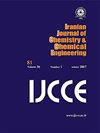Characterization of Phosphorus and GGBF slags as low-cost adsorbents for Cu(II) removal
IF 1
4区 工程技术
Q4 CHEMISTRY, MULTIDISCIPLINARY
Iranian Journal of Chemistry & Chemical Engineering-international English Edition
Pub Date : 2021-06-22
DOI:10.30492/IJCCE.2021.123513.4047
引用次数: 0
Abstract
Cu(II) is one of the pollutants that is exist in the produced wastewater by many industries. According to the World Health Organization (WHO), its concentration should be less than 2 mg/L. In this study, Phosphorus slag (PS) and ground granulated blast-furnace slag (GGBFS) as industrial wastes with the properties of abundant and low cost are used to remove Cu(II). The effects of shaker rotation rate, initial concentration of Cu(II), and amount of adsorbent on the adsorption process are investigated. The adsorption capacity was maximized at a shaking rate of 150 rpm, initial concentration of 50 mg/L, 0.2 g GGBFS per 0.03 liter, and 0.5 g PS per 0.03 liter. At various temperatures, the values of thermodynamic parameters were calculated by measuring the equilibrium data. The results showed that the adsorption process was exothermic using both GGBFS and PS adsorbents. The experimental data of Cu(II) adsorption by GGBFS and PS was fitted well by Langmuir and Freundlich isotherm models, respectively. The maximum adsorption capacity were obtained 156.30 and 151.52 mg/g for GGBFS and PS, respectively. Also, the kinetic modeling indicated that the adsorption process is achieved to the equilibrium state using both adsorbents at less than 5 min.磷渣和GGBF渣作为低成本Cu(II)吸附剂的特性研究
铜(II)是许多工业生产废水中存在的污染物之一。根据世界卫生组织(WHO)的规定,其浓度应低于2毫克/升。本研究以磷渣(PS)和磨粒高炉渣(GGBFS)作为工业废渣,利用其丰富和低成本的特性去除Cu(II)。考察了摇床转速、Cu(II)初始浓度和吸附剂用量对吸附过程的影响。振荡速率为150 rpm、初始浓度为50 mg/L、0.2 g GGBFS / 0.03 L、0.5 g PS / 0.03 L时吸附量最大。在不同温度下,通过测量平衡数据计算热力学参数的值。结果表明:GGBFS和PS两种吸附剂均为放热吸附。GGBFS和PS吸附Cu(II)的实验数据分别用Langmuir和Freundlich等温模型拟合得很好。GGBFS和PS的最大吸附量分别为156.30 mg/g和151.52 mg/g。动力学模拟表明,两种吸附剂在5 min内即可达到吸附平衡状态。
本文章由计算机程序翻译,如有差异,请以英文原文为准。
求助全文
约1分钟内获得全文
求助全文
来源期刊

Iranian Journal of Chemistry & Chemical Engineering-international English Edition
CHEMISTRY, MULTIDISCIPLINARY-ENGINEERING, CHEMICAL
CiteScore
2.80
自引率
22.20%
发文量
0
审稿时长
6-12 weeks
期刊介绍:
The aim of the Iranian Journal of Chemistry and Chemical Engineering is to foster the growth of educational, scientific and Industrial Research activities among chemists and chemical engineers and to provide a medium for mutual communication and relations between Iranian academia and the industry on the one hand, and the world the scientific community on the other.
 求助内容:
求助内容: 应助结果提醒方式:
应助结果提醒方式:


